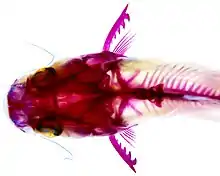Diaphonization
Diaphonization (or diaphonisation), also known as clearing and staining, is a staining technique used on animal specimens that first renders the body of the animal transparent by bathing it in trypsin, and then stains the bones and cartilage with various dyes, usually alizarin red and alcian blue.[1]


History
Diaphonization was first developed in 1977 by Guido Dingerkus and L.D. Uhler.[2] In 2017, several Bulgarian scientists published a set of modified techniques.[3]
Technique
Diaphonization is not suitable for large birds or mammals, both because of the fur and feathers that would get in the way, and due to the limited ability of the trypsin bath to penetrate the tissues of larger animals. It is usually used to preserve animals that are too delicate to dissect, and instead are kept as wet specimens.[1]
References
- Oommen, Ansel (2014-05-14). "Dyeing the Dead: The Artful Science of Diaphonization". Atlas Obscura. Retrieved 2021-02-05.
- Dingerkus, Guido; Uhler, Lowell D. (1977-01-01). "Enzyme Clearing of Alcian Blue Stained Whole Small Vertebrates for Demonstration of Cartilage". Stain Technology. 52 (4): 229–232. doi:10.3109/10520297709116780. ISSN 0038-9153. PMID 71769.
- "(PDF) Elaboration of transparent biological specimens for visualisation of developing cartilage and bone". ResearchGate. Retrieved 2021-02-05.
| Wikimedia Commons has media related to Cleared and stained specimens. |